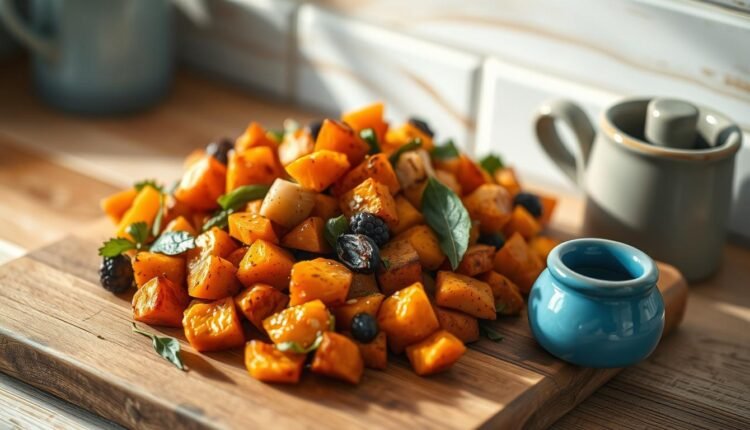Low Sugar Breakfast Hash Recipe With Hidden Vegetables
Sneak more veggies into your morning with our tasty low sugar breakfast hash recipe. A healthy, easy-to-prepare breakfast option for busy professionals and families.
I nearly forgot my keys three times last Tuesday while juggling school lunches and a work call. That’s when I realized: we need meals that multitask as hard as we do. Enter this savory sweet potato hash – your new kitchen ally for turning chaotic mornings into nourishing wins.
This dish isn’t just about fueling your day. It’s about cleverly packing vitamin-rich veggies into golden cubes of caramelized sweet potato. The natural sweetness becomes your flavor hero, letting us skip added sugars while keeping taste buds happy. I’ve watched even the pickiest eaters (kids and adults alike) clean their plates without suspecting the rainbow of nutrients underneath.
What makes it work for real life? You can roast a batch Sunday night, then reinvent it all week. Toss it with eggs for sunrise fuel, layer it in grain bowls at noon, or pair it with roasted chicken when dinner chaos strikes. The magic lies in that orange tuber – packed with fiber to keep energy steady until your next meal.
Why this works:
- Hidden vegetables meet morning comfort food
- 30-minute prep time with make-ahead flexibility
- Equally home in brunch skillets or dinner bowls
Introduction
Between soccer practice and back-to-back Zoom meetings, my kitchen often looks like a tornado hit it by 8 AM. That’s why this dish became my weekday MVP. It’s not just about eating—it’s about reclaiming mornings with something hearty that reheats like a dream.
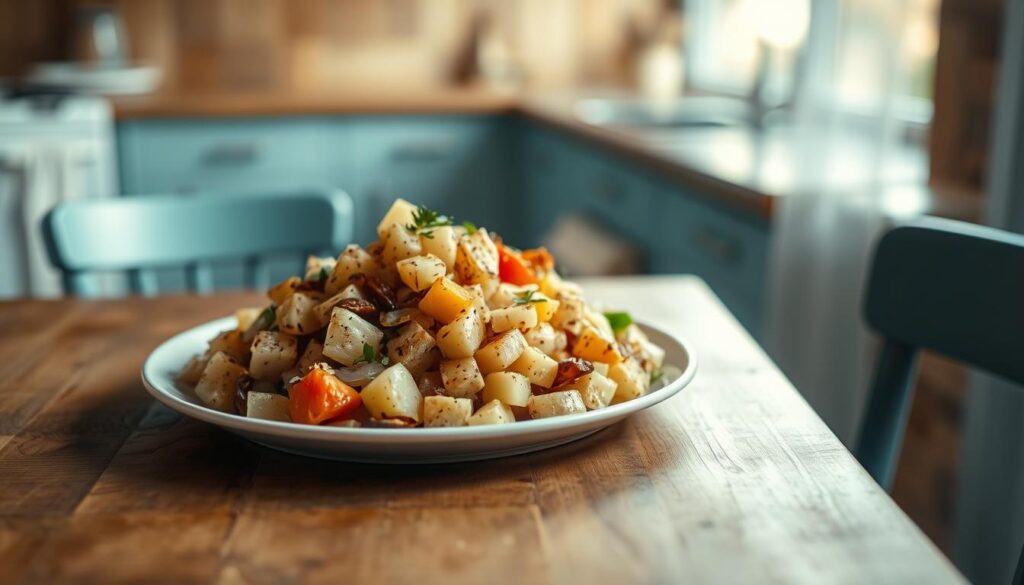
The magic starts with two pantry staples: salt and pepper. A generous pinch of each transforms humble ingredients into something special. Russet potatoes crisp up beautifully, while sweet varieties add natural caramelized notes. Together, they create that perfect balance of crunchy and tender.
Eggs tie everything together, adding creamy richness and staying power. Scramble them right into the skillet or fry them sunny-side up—either way, you’re getting 6 grams of protein per serving. What I love most? This dish evolves beautifully. Tuesday’s breakfast becomes Wednesday’s lunch wrap filling without missing a beat.
| Potato Type | Texture | Prep Tip |
|---|---|---|
| Russet | Crispy edges | Soak 10 mins pre-cooking |
| Sweet | Caramelized | Cube smaller for even roasting |
You’ll notice I don’t fuss with complicated techniques here. A hot skillet and basic seasoning do the heavy lifting. Later sections break down exactly how to layer flavors and adapt the base recipe—whether you’re cooking for one or feeding a crowd.
Understanding the low sugar breakfast hash recipe
Burned toast smoke still haunts my Thursday mornings. That’s when I perfected this flavor-packed skillet strategy—where every element plays multiple roles. Let’s unpack how smart ingredient choices create satisfying depth without relying on sweeteners.
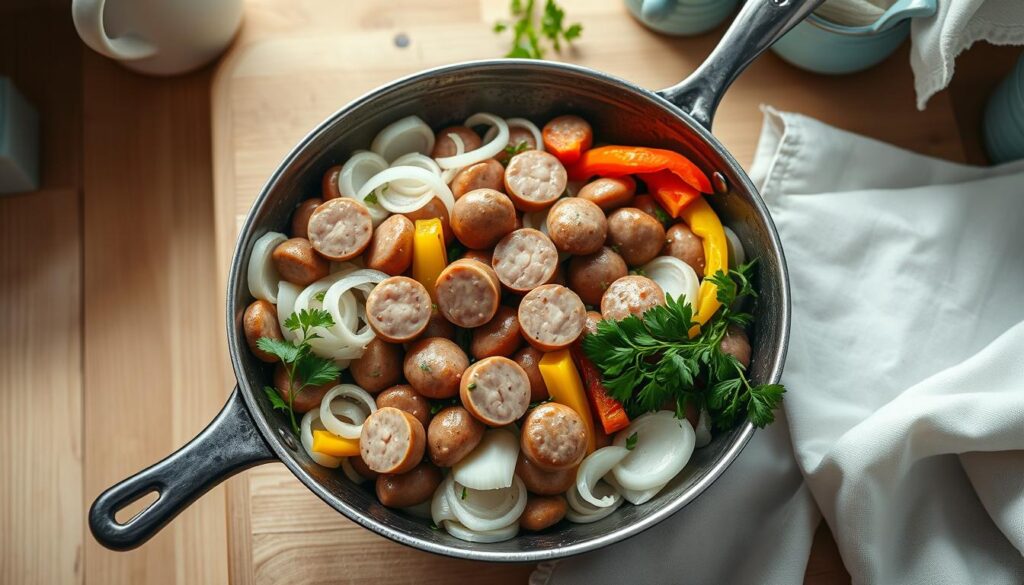
Caramelized onion forms the flavor foundation. Cooked slowly over medium heat, its natural sugars emerge without added sweeteners. This golden base balances earthy veggies and rich proteins. Control your burner’s intensity—too high scorches; too low creates mush.
Quality proteins elevate the dish. Chicken sausage brings lean smokiness, while uncured bacon adds salty crunch. Both pack savory umami that satisfies cravings. Here’s how they compare:
| Protein | Flavor Profile | Cooking Tip |
|---|---|---|
| Chicken Sausage | Herbaceous, smoky | Brown before adding veggies |
| Turkey Bacon | Salty, crisp | Bake separately for crunch |
Veggies like zucchini and bell peppers add texture and nutrients. Sauté them just until tender—overcooking kills vibrancy. The right heat level preserves color and crunch.
This formula adapts to your fridge contents. Swap spinach for kale. Use mushrooms instead of peppers. The core technique remains: layer flavors through controlled cooking stages. Your skillet becomes a flavor-building machine.
Essential Ingredients and Nutritional Benefits
Last month, I almost served my niece cereal for dinner—again—when a work emergency hijacked my evening. That’s when I discovered the power of strategic ingredients. Every element in this dish pulls double duty, delivering flavor and nourishment without demanding extra prep time.
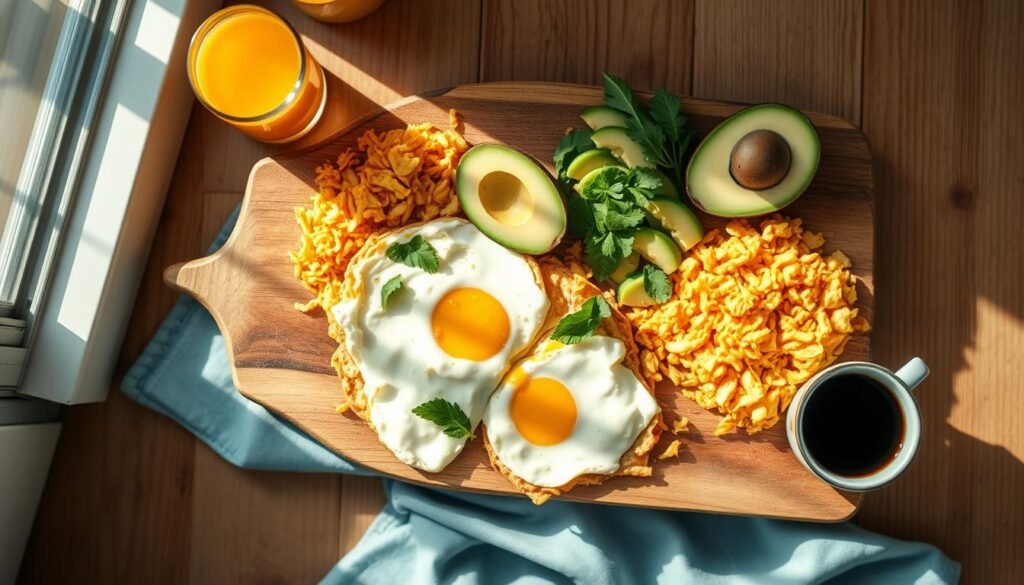
Vegetable Ninja Moves
Leafy greens like kale and Swiss chard disappear into the mix while packing vitamins A and C. Brussels sprouts bring crunch and fiber when shredded thin. These veggies work best when prepped ahead—wash and chop during Sunday meal prep to save weekday minutes.
| Vegetable | Key Nutrients | Prep Tip |
|---|---|---|
| Kale | Vitamin K, Iron | Massage leaves to soften |
| Brussels Sprouts | Vitamin C, Fiber | Shred with mandoline |
| Swiss Chard | Magnesium, Potassium | Remove stems for quicker cooking |
Smart Swaps Made Simple
Avocado oil handles medium heat beautifully, keeping its healthy fats stable. Garlic adds depth without sodium, while bell peppers contribute sweetness naturally. Try these upgrades:
| Regular Ingredient | Healthier Swap | Benefit |
|---|---|---|
| Butter | Olive oil | Heart-friendly fats |
| Sour cream | Mashed avocado | Creamy texture + fiber |
| White onion | Roasted garlic | Antioxidant boost |
Cook vegetables at medium heat to preserve nutrients that break down under high temps. Stirring occasionally lets colors stay vibrant while developing caramelized edges. This balance keeps meals satisfying and energy levels steady.
Step-by-Step Guide to Prep and Cook
Last week, my blender decided to retire mid-smoothie, reminding me that kitchen wins require smart systems, not just gadgets. Let’s walk through this methodical approach that turns chopping and sautéing into clockwork efficiency.
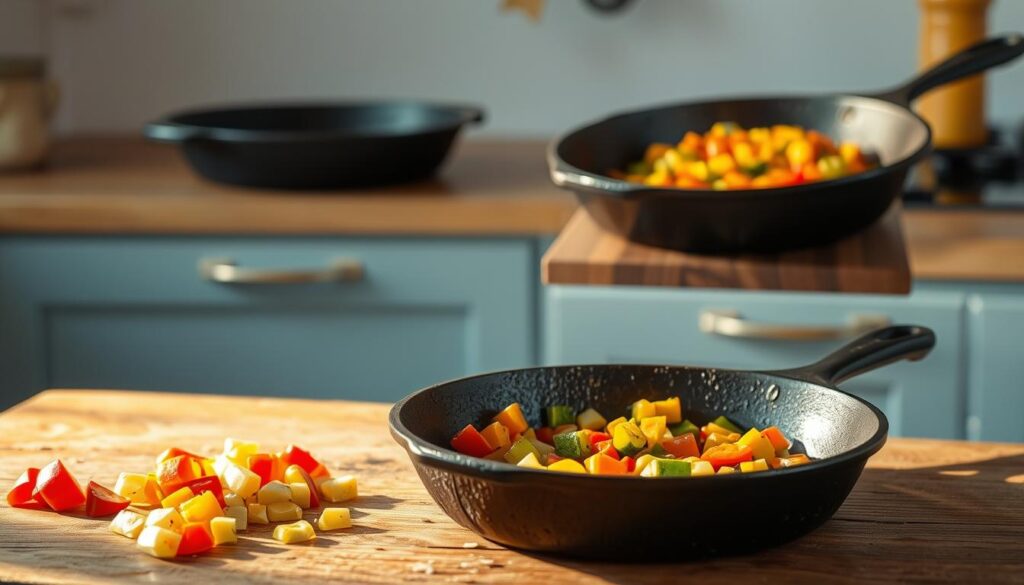
Prepping Ingredients Effectively
Start by microwaving cubed sweet potatoes for 2 minutes. This softens them for faster browning later. While they steam, chop onions and bell peppers into uniform pieces—this ensures even cooking. Keep greens like spinach or kale ready in a separate bowl.
| Prep Task | Time Needed | Pro Tip |
|---|---|---|
| Vegetable Chopping | 5 minutes | Use pre-printed guides for consistent sizes |
| Potato Pre-Cook | 2 minutes | Microwave in glass container |
| Garlic Prep | 1 minute | Crush cloves with knife side |
Cooking Techniques for Optimal Flavor
Heat your skillet over medium for 90 seconds before adding oil. I recommend a Staub cast iron pan—its heavy base prevents hot spots. Add 1 tbsp oil, then sauté garlic until fragrant (about 30 seconds). Stir continuously to avoid burning.
Add prepped vegetables in stages: potatoes first, then firmer veggies like peppers. Cook 8 minutes total, flipping halfway. Reduce heat if edges darken too quickly. A well-seasoned skillet creates that golden crust we all crave.
Printed instructions help track timing without phone distractions. Keep them near your workstation for quick glances. Remember: proper heat management locks in nutrients while building complex flavors layer by layer.
Tips, Techniques, and Kitchen Tools
My favorite skillet once slid halfway off the stove mid-sauté—a smoky reminder that tools matter as much as ingredients. Let’s explore how the right equipment and techniques can turn kitchen chaos into consistent results.
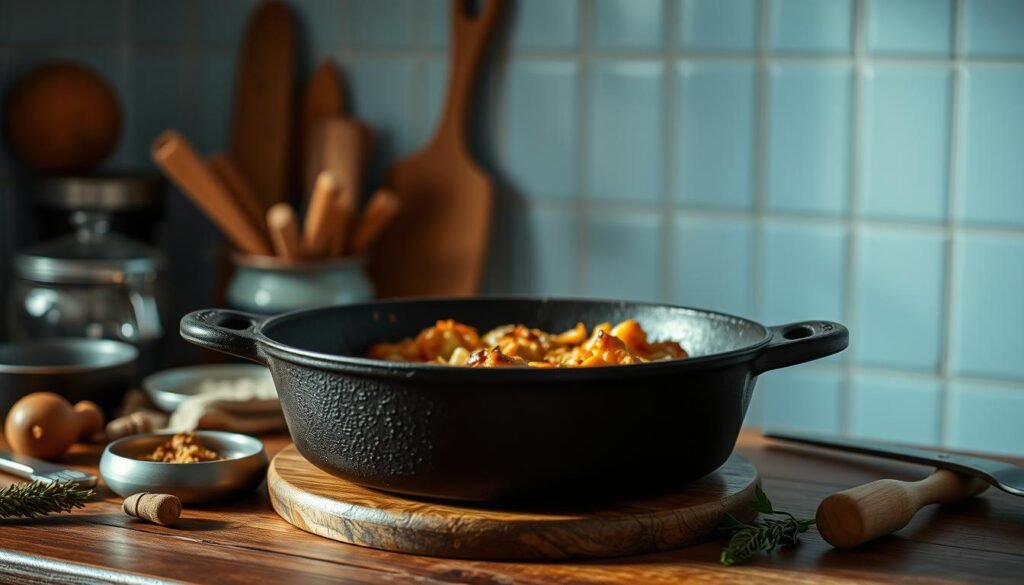
Skillet Selection Secrets
Cast iron reigns supreme for heat retention, while stainless steel offers quick temperature adjustments. Non-stick pans work for quick veggie flips but lack browning power. Your choice depends on cooking style:
| Material | Heat Distribution | Best For |
|---|---|---|
| Cast Iron | Even, slow | Caramelizing veggies |
| Stainless Steel | Fast, responsive | Pan sauces |
| Non-Stick | Uneven | Quick scrambles |
Season skillets with coarse salt and olive oil weekly. Rub 1 tsp salt into warm surfaces to remove residue, then coat with oil. This creates a natural non-stick layer.
Chicken sausage variations shine when browned in cast iron. Crumble spicy Italian links for bold flavor or use apple-sage links to complement caramelized veggies. Always pre-cook firmer vegetables like carrots—microwave 90 seconds to soften before sautéing.
Trusted recipes agree: a pinch of pepper added during cooking develops deeper flavor than post-cook seasoning. Stir in ¼ tsp when veggies start sizzling for aromatic warmth.
Flavor Variations and Protein Options
I once grabbed ground turkey instead of beef for tacos—and discovered how protein swaps can transform familiar dishes. This recipe thrives on that same flexibility. Let’s explore how to reinvent your skillet while keeping its nourishing core intact.
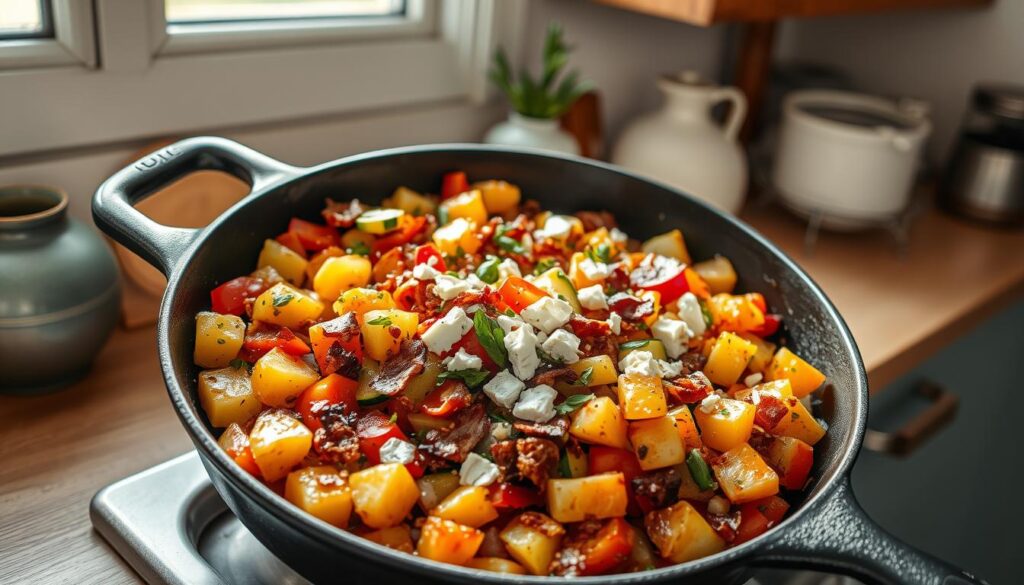
Incorporating Different Proteins
Your skillet becomes a protein playground. Smoky chicken sausage adds depth, while crumbled turkey bacon offers salty crunch. For plant-based options, try marinated tempeh or seasoned lentils. Each choice brings unique textures:
| Protein | Cooking Method | Flavor Boost |
|---|---|---|
| Chicken Sausage | Pan-sear first | Fennel seeds |
| Turkey Bacon | Bake separately | Smoked paprika |
| Breakfast Sausage | Brown in skillet | Sage & thyme |
Breakfast sausage works beautifully when crumbled into the mix. Opt for lean versions to keep things light. Want to add sweet undertones? A teaspoon of maple syrup in the seasoning blend balances savory elements.
Swapping Veggies for Creative Twists
Bell peppers aren’t the only stars here. Try diced zucchini for moisture or rainbow chard for earthy notes. The key? Adjust cooking times based on texture:
| Vegetable Swap | Prep Tip | Nutrition Perk |
|---|---|---|
| Butternut Squash | Roast first | Vitamin A |
| Bell Pepper | Slice thin | Vitamin C |
| Spinach | Add last | Iron boost |
Make sweet potato variations by combining orange and white varieties. Their natural sugars caramelize differently, creating complex flavor layers. For extra color, toss in purple sweet potatoes—they hold shape well during cooking.
Remember: this dish evolves with your cravings. Keep a base of roasted sweet potatoes, then build outward. Your future self will thank you when Tuesday’s dinner comes together in 10 minutes flat.
Serving Suggestions and Meal Pairings
Last-minute brunch guests arrived just as my coffee brewed last Sunday. That’s when I learned the power of strategic pairings—transforming a simple skillet into a complete spread. The right combinations turn your make-ahead sweet potato base into three distinct meals before noon.
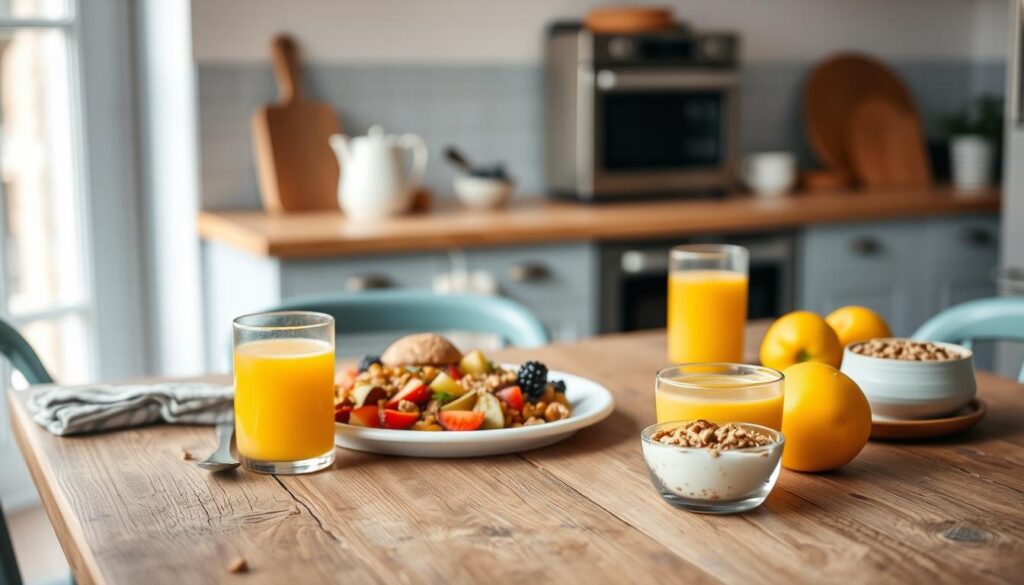
Flavor Harmony Essentials
Balance textures and nutrients with these mix-and-match options. Creamy avocado slices soften crispy potato edges, while tangy Greek yogurt adds protein-rich contrast. Try these crowd-pleasing combinations:
| Side Dish | Prep Time | Flavor Boost |
|---|---|---|
| Roasted veggies | 15 mins | Toss with olive oil + rosemary |
| Fruit cups | 5 mins | Mix berries + mint |
| Yogurt parfait | 3 mins | Layer with granola |
Drizzle quality olive oil over servings for richness—its peppery notes enhance caramelized veggies. Fresh herbs like chives or dill add bright accents without overpowering. For lunches, pair with massaged kale salad dressed in lemon-olive vinaigrette.
Keep things light with seasonal fruit cups or cucumber slices. The crisp textures contrast beautifully with warm hash. Remember: meals become memorable through thoughtful contrasts—creamy vs crunchy, sweet vs savory, warm vs cool.
Customize plates with pickled onions or toasted nuts. Your skillet creation adapts to any craving while delivering balanced nourishment. What toppings will make your taste buds sing today?
Conclusion
Last weekend, my neighbor dropped by unexpectedly just as I was scrambling to feed the kids. That’s when this versatile dish became my kitchen hero once again. Golden vegetable cubes caramelized to perfection, ready to transform into multiple servings across three chaotic days.
What makes this approach work? You control the flavors. Swap proteins based on what’s in your fridge. Adjust spice levels for tiny taste buds. Those colorful cubes hold their texture through reheating, making them ideal for meal prep warriors.
Don’t underestimate the power of a creative garnish. A sprinkle of fresh herbs or diced avocado can elevate simple ingredients. Pair your creation with a bright citrus side or protein-packed yogurt for balanced nourishment.
The magic lies in balancing earthy roasted notes with fresh accents. Sweet potatoes offer natural depth, while caramelized onions add subtle complexity. Every bite delivers satisfaction without heavy sauces or complicated techniques.
Here’s my challenge to you: Top your next batch with something unexpected. Toasted pepitas? Quick-pickled radishes? Tag me @ChefCallieEats – I want to see how you make it yours. Because truly great meals aren’t about perfection. They’re about nourishing your people with what works today.

